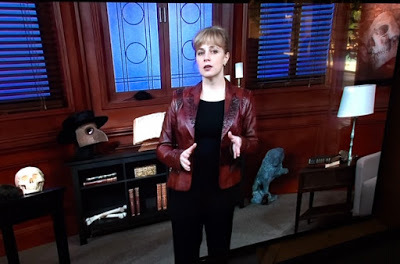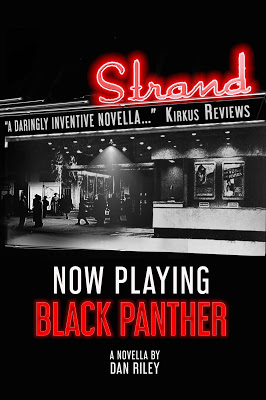Between the Black Death and Us
 Prof. Dorsey Armstrong bringing the Black Death home
Prof. Dorsey Armstrong bringing the Black Death homeAt the beginning of this thing, I posted a listing of what I thought were good viewing options for those looking for new things to watch during the pandemic. Since posting that list, I’ve come upon a Must-See new option. It’s called The Black Death, the World’s Most Devastating Plague. It’s probably a show we wouldn't ever have watched had the current crisis not so immersed us in the pathology of disease…and Amazon Prime* probably would not have recommended it for us. So just when it seems the world is falling apart all around us, serendipity still manages to rear its little bobblehead.To say the show is hosted by Professor Dorsey Armstrong, Medieval scholar at Purdue University, is an understatement. She is the show. She roams deliberately before the camera over a donnish set, weaving a compelling narrative of the Black Plague bolstered by scholarship and presentation skills, aided occasionally by graphics of line drawings, paintings, animated maps and pull quotes. This is an old school college lecture, where video razzmatazz and high tech computer tricks take a back seat to erudition and oral tradition. It’s among the best college courses I’ve ever experienced, which is why half way through its two-dozen 30-minute lectures my head is exploding.It’s not just the history of the Black Plague that’s so riveting, it’s the echoes of it in our battle against Covid-19. One would think the show was purposely designed to draw parallels between 1348 and 2020, but the show was put together in 2016, which makes the comparisons between then and now even more eerie based on happenstance alone. Generally speaking the links consist of failure of political leadership, economic devastation, overwhelming of care capabilities, and civic unrest. Travel is restricted from plague-designated areas. There is the inevitable scapegoating of “others”-–during the Plague it was the Jews, rather than the Chinese now…or old people or brown people.
Most fascinating of all is that with all the death and devastation the Plague wrought, it also brought with it fundamental and one might say progressive changes. With the rich and clergy being wiped out in comparable numbers, it served to lessen their mystical hold on the lower classes. With mass deaths at all levels of society, it created significant gaps in the labor force. But because peasants existed in such greater proportional numbers they were able to survive and in doing so realize freedoms they hadn't been able to before. Mainly they were no longer tethered to the manors they'd lived and worked on for generations and could take their labor elsewhere. Moreover they were now able to make wage demands rather than just take what they were given. One can imagine how much easier the Fight for 15 is going to become in the months ahead in our own time.
On the opposite end of the coincidence spectrum, even back then the Swedes marched to the beat of their own drum…continuing to gather in homes of the sick and for funerals. Which, speaking of funerals, reminds me: Lorna and I have taken to watching the lectures during lunch, a sometimes un-appetizing ordeal. During one viewing we were eating lasagna when Dr. Armstrong described burial in mass graves as a single layer of bodies covered with a layer of dirt, covered with another layer of bodies, covered with another layer of dirt…like a lasagna, she said. Gag me with a spoon!Despite the widely held view that the Plague years saw depressing acts of abandonment of diseased family and friends as well as cruelty against diseased strangers, there are stories of remarkable bravery and sacrifice. In Norway, an Icelandic sailor came down with the Plague before his ship set sail back to Iceland. The ship’s captain and crew decided to stay behind in plague-ravaged Norway rather than carry it home with them--an act of courage that spared Iceland from the Black Death for another half century. In another instance, the Black Death came to Florence in the person of a sick seaman who arrived at the door of a friend seeking refuge. In granting it, this Florentine Good Samaritan doomed his city to lose 80% of its population in 1348. The rapaciousness of the Plague, however, strongly suggests that if not that particular sailor, another Patient Zero would have been close behind.That sailor was a refugee from the city of Caffa (present day Ukrainian territory). In 1266 Genoa had negotiated rights to the port city with a Mongol Kahn to facilitate trade between the two. But new Mongol leadership a century later wanted the city and laid siege to it. While encamped on the outskirts, the Mongols were attacked by rats bearing the plague and started dying off. In a stratagem worthy of Game of Thrones, the Mongols started catapulting diseased cadavers of their comrades over the walls of Caffa, thus infecting the Genoese traders in one of history's first recorded acts of biological warfare. The Italians escaped on their ships, but only to take the Plague with them to Italy, and from there to greater Europe. Those who do not learn the lessons of history are doomed to repeat it has become such a cliche that its meaning has just about been lost (if not outright challenged...). In this series, Dorsey Armstrong serves the lesson up to us in very palatable, bite-sized portions and leaves it to us to gag on it or not.
* The first 9 lectures are available for free from Prime; the rest are available through a paid Great Courses membership, but that also offers a 7-day free trial...so if you binge...or cram as we used to call it college, you can get through them all at no cost.
Now a word from our Corporate Overlord: Now Playing Black Panther

Published on July 02, 2020 14:26
No comments have been added yet.



